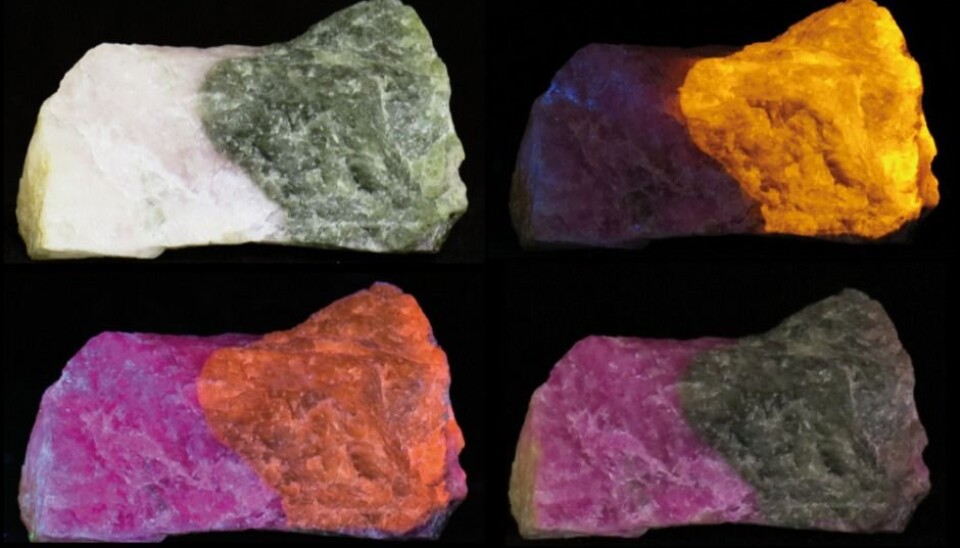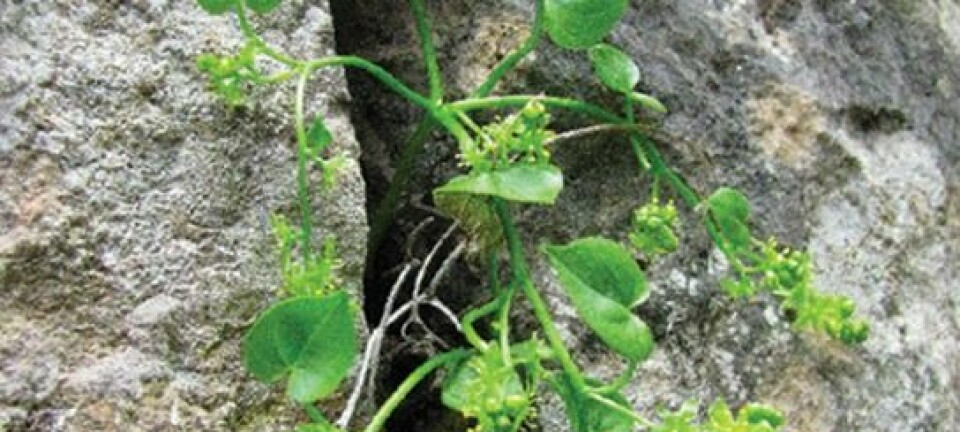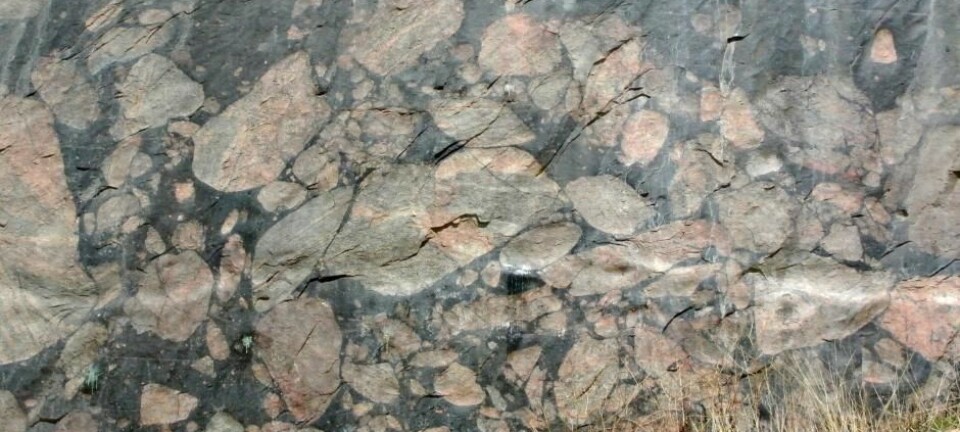
This rock switches colours in an instant
Sodalite deposits are found on South Greenland, Canada, Russia and other countries including Norway, and are famous for their chemical colour tricks.
The chunk of rock pictured above can change into four different colour displays. It is hackmanite, the name given to the mineral sodalite that has this capability. The mineral shifts colour on its own, simply coaxed by doses of light from different wavelengths of the electromagnetic spectrum, including long-wave and short-wave ultraviolet light.
Sodalite rocks can even be boulders several metres in diameter. Some not only change colour but also fluoresce when charged with UV light.
But the process is reversible and they switch back to their original colour when placed in regular sunlight.
If you hold the piece of sodalite under a UV lamp again you have a glowing mineral in your hands. It doesn’t take more than a few seconds. This transformation can be repeated endlessly. Bars at discotheques have been known to install bar-tops made of sodalite to wow the clientele.

Mineralogist Henrik Friis has chosen this as his favourite object.
Rare
Friis is an associate professor in the mineralogical research group of the University of Oslo’s Natural History Museum.
He is a Dane who has been passionate about rocks since childhood.
“I started collecting minerals when I was eleven. That it isn’t so easy when you live in Denmark,” he jokes.

“There isn’t that much rock there. We have sand – lots of sand! But we had many vacations in Norway.”
Friis was 14 or15 the first time he heard of the colour-shifting mineral sodalite.
Not all types of sodalite, to be specific, just the variety that formed in very alkaline rocks, which is not found many places on the planet.
But you can come across them in the Larvik area, south of Oslo, or at Sørøya in Vest-Finnmark County. And on south Greenland, which is where Henrik Friis encountered the mineral in the rough for the first time.
Fascination
This was in 1999. When Friis was getting his bachelor degree he partook in an expedition led by the curator at the University of Copenhagen Geological Museum – who later would be his advisor when Friis got his master degree.
“We took samples and found a chunk of sodalite. I hammered at it until it split open. It was purple, but then it turned green. It changed colours right before my eyes.
“It was a kick. This changing of colour is called photochromism, just as with glasses which darken and act as sunglasses when exposed to sunlight. I had known about this for some time but experiencing it first-hand was fabulous.”
“Most of what I study is just a millimetre in size and not so impressive for the general public. But sodalites come in large chunks that can shift colour, so there is this constant transformation.
South Greenland and a view of an area with alkaline rock types. Plenty of colour-changing sodalite rock is found here. (Photo: Henrik Friis)
But how can a rock carry on like a chameleon?
Geologists in the 1800s were well aware that alkaline sodalites changed colours when lit by various types of rays. The experiments with the rocks were entertaining, but the weird colour shifts baffled scientists.
“It was in the late 1800s and curiosities were in the vogue. So they used radioactivity and made lots of experiments with such minerals, including exposing them to radium and the new magic discovery – x-rays."
“Radium was a big hit at the time so they exposed the minerals to it and to both sunlight and x-rays to see what happened. Such antics would not be so common now.”
“There are a few other minerals that change in this way but sodalite is what does it the best.”
New discovery
About 70 years after the scientific descriptions of the colour changes, someone suggested this could be related to the content of sulphur in the mineral.
Friis says this is right. Here is the short version of the best explanation science has to date:
Sodalite undergoes a change in structure and chemistry when struck by light, and this alters its colour.
More specifically – sodalite, like most minerals, is a chemical compound with an orderly arrangement of atoms in a crystalline form. Sodalite has some holes in its lattice structure. Collections of atoms fill these empty spaces – chlorine atoms and sodium atoms. Sometimes the chlorine atoms in the sodalite are replaced by sulphur atoms. These two types of atoms cannot both be there simultaneously. If sulphur fills the cavity, chlorine has to take an exit.
When that happens an empty spot is created.
“When the structure of the piece of sodalite is exposed to UV light, an electron from this cavity will jump up to where the sulphur atom is and into the empty cavity next to it,” says Friis.
This is when the sodalite changes colour.
When more energy is added, which occurs when the mineral is exposed to sunlight, the electron jumps back into the cavity with sulphur and the colour changes back again.
One of Friis’s master students, Teresa Zahoransky, recently discovered something new about sodalite’s colour trick.
“We often find that when increasing amounts of sulphur are added we get stronger effects, until it stops.
“But what Teresa Zahoransky found in sodalite was that the effect is actually greatest when extremely small amounts of sulphur are present. This is because as more impurities are added the crystal structure changes – enough to ruin the effect,” says Friis.
Can sodalite’s colour trick have a useful application?
“I am always eager to relate to people that a mineral is actually a chemical product and new ideas for materials with uses in high-tech industries could turn up,” Friis says.
Friis has a lot experience collaborating with chemists in his approach to minerals. Attention needn’t be on the utilisation of minerals as sources of elements such as gold, silver or copper. We can learn from chemists and make use of their characteristics in a creative way.
“Minerals are really just chemical compounds created naturally and sometimes they have properties we don’t know from laboratories.”
Friis suggests sodalite as a possible example:
What if we could use the chemistry and structure in sodalite in paper currency as an extra element of security against counterfeiting?
If the ability of sodalite to change colour could be recreated in paper currency it would be no problem to check the authenticity by laying them under ultraviolet light. The entire bill would change colour, points out Friis.
“I don’t just think of this as a mineral but as a chemical compound. The only difference between mineralogists and chemists is that we find things in nature whereas chemists mix things together themselves,” he says.
“We mineralogists describe things but we are not as good at dreaming up applications. We are happy to have made some discovery. We think it’s cool, and then we go off to the next task.”
“This is why it is very fun to work with physicists and chemists, as they have a totally different approach. Their point of departure is often some social problem or need that should be solved. So when we get together the results can be really interesting.”
-------------------------------------
Read the Norwegian version of this article at forskning.no
Translated by: Glenn Ostling

































